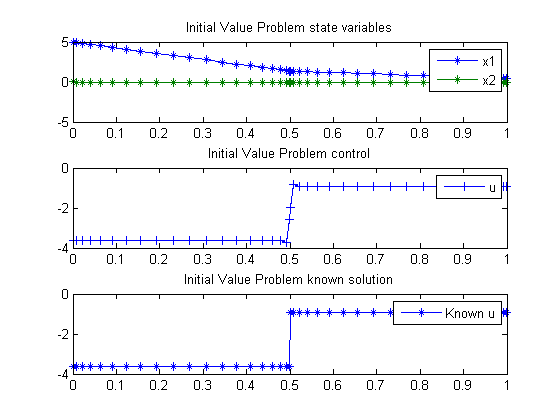« Previous « Start » Next »
52 Initial Value Problem
On some linear-quadratic optimal control problems for descriptor systems. Galina Kurina, Department of Mathematics, Stockholm University, Sweden.
2.5 Necessary control optimality conditions is not valid in general case.
52.1 Problem Description
Find u over t in [0; 1 ] to minimize:
| J = | | *x12(0.5) + | | *x12(1) + | | * | ∫ | | u2 dt |
subject to:
Reference: [21]
52.2 Problem setup
toms t1
p1 = tomPhase('p1', t1, 0, 0.5, 20);
setPhase(p1);
tomStates x1p1 x2p1
tomControls x3p1 up1
% Initial guess
x01 = {icollocate({x1p1 == 0; x2p1 == 0})
collocate({x3p1 == 0; up1 == 0})};
% Boundary constraints
cbnd1 = initial({x1p1 == 5; x2p1 == 0});
% ODEs and path constraints
ceq1 = collocate({
dot(x1p1) == x3p1+up1
dot(x2p1) == x2p1-x3p1+up1
dot(x2p1) == 0});
% Objective
objective1 = 0.5*final(x1p1)^2+0.5*integrate(up1.^2);
toms t2
p2 = tomPhase('p2', t2, 0.5, 0.5, 20);
setPhase(p2);
tomStates x1p2 x2p2
tomControls x3p2 up2
% Initial guess
x02 = {icollocate({x1p2 == 0; x2p2 == 0})
collocate({x3p2 == 0; up2 == 0})};
% ODEs and path constraints
ceq2 = collocate({
dot(x1p2) == x3p2+up2
dot(x2p2) == x2p2-x3p2+up2
dot(x2p2) == 0});
% Objective
objective2 = 0.5*final(x1p2)^2+0.5*integrate(up2.^2);
objective = objective1 + objective2;
% Link phase
link = {final(p1,x1p1) == initial(p2,x1p2)
final(p1,x2p1) == initial(p2,x2p2)
final(p1,x3p1) == initial(p2,x3p2)};
52.3 Solve the problem
options = struct;
options.name = 'Initial Value Problem';
options.solver = 'snopt';
constr = {cbnd1, ceq1, ceq2, link};
solution = ezsolve(objective, constr, {x01, x02}, options);
Problem type appears to be: qp
Starting numeric solver
===== * * * =================================================================== * * *
TOMLAB - Tomlab Optimization Inc. Development license 999001. Valid to 2011-02-05
=====================================================================================
Problem: 1: Initial Value Problem f_k 4.550747663987713100
sum(|constr|) 0.000000000451074017
f(x_k) + sum(|constr|) 4.550747664438787000
f(x_0) 12.499999999999893000
Solver: snopt. EXIT=0. INFORM=1.
SNOPT 7.2-5 NLP code
Optimality conditions satisfied
FuncEv 1 Iter 23 MinorIter 142
CPU time: 0.031250 sec. Elapsed time: 0.031000 sec.
52.4 Plot result
subplot(3,1,1)
t = [subs(collocate(p1,t1),solution);subs(collocate(p2,t2),solution)];
x1 = [subs(collocate(p1,x1p1),solution);subs(collocate(p2,x1p2),solution)];
x2 = [subs(collocate(p1,x2p1),solution);subs(collocate(p2,x2p2),solution)];
u = [subs(collocate(p1,up1),solution);subs(collocate(p2,up2),solution)];
plot(t,x1,'*-',t,x2,'*-');
legend('x1','x2');
title('Initial Value Problem state variables');
subplot(3,1,2)
plot(t,u,'+-');
legend('u');
title('Initial Value Problem control');
subplot(3,1,3)
plot(t,-8/11*5*(t<0.5)-2/11*5*(t>=0.5),'*-');
legend('Known u');
title('Initial Value Problem known solution');

« Previous « Start » Next »